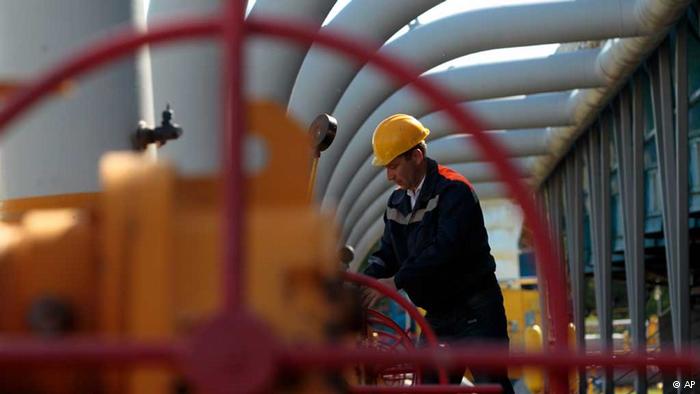
More Competition, Less Expensive Russian Gas in Ukraine’s Market (Part One)
Publication: Eurasia Daily Monitor Volume: 12 Issue: 62
By:

On April 1, on President Vladimir Putin’s instructions (Kremlin.ru, March 31; Interfax, April 1), Prime Minister Dmitry Medvedev prolonged the validity of the existing agreement on Russian natural gas supplies to Ukraine until June 30, effective immediately.
Originally signed by Russian Gazprom and Naftohaz Ukrainy last October, the agreement was in force from November 1, 2014, through March 31, 2015, (the winter heating season) with a price discount. That “winter package” agreement (see EDM, March 18) has now been prolonged, including that discount, until the end of the second quarter of 2015, as part of a “summer package.” This looks likely to be carried over into the third quarter. The European Commission is mediating these negotiations at each stage.
While Russia persists with full-spectrum conflict operations against Ukraine, there is overlapping interest on both sides to insulate the Russia-Ukraine gas trade and the gas transit to Europe from the impact of the ongoing conflict. The European Union encourages this understanding of the overlapping interest.
Although the agreement’s prolongation looks like a short-term measure, it reflects far-reaching changes on the energy markets in Europe and Ukraine. Those changes are increasingly neutralizing Russia’s ability to pressure Ukraine and Europe through manipulation of gas supplies and transit. As long as Ukraine carries a major portion of Russian gas exports to Europe, the Kremlin can no longer impose extortionate gas prices on Ukraine or threaten it with supply cutoffs, as in previous years. For Moscow to do so in the currently evolving market conditions (see below) would be to risk defaulting on Russia’s supply commitments to Europe and losing markets there.
Thanks to EU market liberalization and Central Europe interconnections, European energy companies are themselves gaining market share against Gazprom in Ukraine. No longer bound by Gazprom’s bans on re-export to third countries, European companies resell gas of Russian and other origins in growing volumes to Ukraine. Ongoing expansion of reverse-flow pipeline capacities, particularly through Slovakia, makes this possible. This means differentiation of the gas suppliers and routes to Ukraine. The Ukrainian gas market is becoming a competitive market with alternative import options.
In the bilateral Russia-Ukraine gas trade, the Ukrainian market seems about to begin turning from a seller’s into a buyer’s market. While Ukraine gains access to non-Gazprom alternatives, the country’s overall natural gas demand is down as a result of war and recession. Planned energy conservation measures promise to cap that demand after recovery from recession. Gazprom’s sales to Ukraine have declined both in market share and in quantitative terms, with correspondingly shrinking revenues. In this situation Gazprom, and behind it the Kremlin, have little choice but to keep selling gas to Ukraine and be flexible on prices, even amid the Kremlin-led war on Ukraine.
Moscow could not seriously prevaricate at this time in the gas negotiations with Ukraine. The EU-mediated negotiation to prolong the agreement proceeded relatively smoothly.
On pricing, the “summer package” carries over the winter-time price discount for Ukraine. On volume, the agreement’s prolongation should enable Ukraine to begin storing sufficient Russian gas for subsequent delivery to Europe, in anticipation of next winter’s heating season.
Under Medvedev’s April 1 governmental decision (postanovlenie), Gazprom continues granting the price discount to Ukraine on the same terms as during the winter just past. The discount is relative to the fluctuating price of the gas at any given time. At a sale price exceeding $330 per one thousand cubic meters, a discount of $100 applies. At a sale price below $330 per one thousand cubic meters, a discount of 30 percent applies in correlation with that price. The financial mechanism of applying the discount operates by deducting Russia’s gas export duty from the price charged to Ukraine. The Russian state budget absorbs that loss (RIA Novosti, April 1).
This discount’s value and methodology are based on the inter-state agreement of 2010 (gas price discount to Ukraine in return for long-term Russian naval basing rights in Crimea). Russia, however, repudiated that agreement shortly after annexing Crimea from Ukraine in March 2014. At that time Moscow cited (inter alia) Ukrainian debts for past supplies of gas.
The “winter [2014–2015] package” marked the resumption of Russian gas sales to Ukraine. The winter agreement introduced, and the summer 2015 agreement maintains, pre-payment by Ukraine for Russian gas supplies. Ukraine has recently been pre-paying in small installments, for a few days’ worth of gas supplies at a time. Ukrainian pre-payments covered Russian gas delivered until March 31, on which date Gazprom halted its deliveries (Gazprom press release, March 31).
According to Ukrainian energy minister, Volodymyr Demchyshyn, Kyiv’s decisions on whether to procure gas from Gazprom, and in what volume, would partly depend on comparing the prices offered by Gazprom and by European companies, respectively (Interfax-Ukraine, April 1). It is an opening gambit for negotiation, made possible by diversified options newly available to Ukraine.
The Ukrainian government had initially sought prolongation of the expired “winter package” until the end of the next winter’s heating season, October 2015–March 2016. Moscow, however, insisted on a three-month solution, hoping for a subsequent rise in world oil prices, to which the Russian natural gas price for Ukraine is pegged. The European Commission advised Kyiv to seize Moscow’s offer at this time and continue negotiations in the tripartite format—Russia, Ukraine, the EU—to bring forward an agreement for next winter’s entire heating season. The European Commission’s Vice President Maros Sefcovic, responsible for the Energy Union, mediates these negotiations (EurActiv, April 2).




